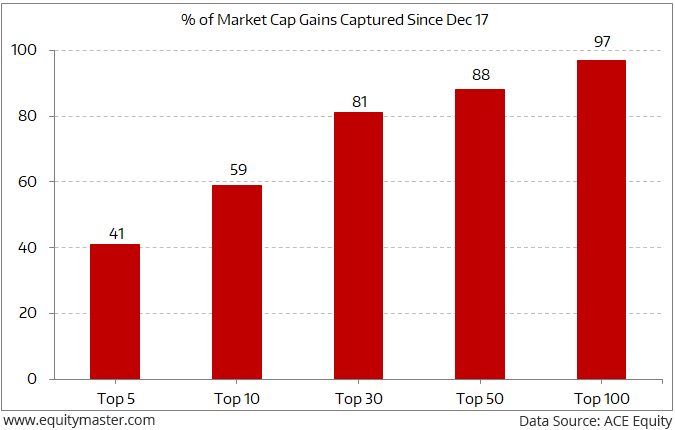Investment in securities market are subject to market risks. Read all the related documents carefully before investing
Grab Our Small Cap Recommendation
Service at a 60% Discount
- Home
- Todays Market
- Indian Stock Market News January 2, 2020
Sensex Ends 314 Points Higher; Capital Goods and Metal Stocks Witness Huge Buying Thu, 2 Jan Closing
Indian share markets ended their trading session on a positive note today.
At the closing bell, the BSE Sensex stood higher by 318 points (up 0.8%) and the NSE Nifty closed higher by 100 points (up 0.8%).
The BSE Mid Cap index ended up by 1.2%, while the BSE Small Cap index ended the day up by 1.4%.
On the sectoral front, gains were seen in the power sector and IT sector. Auto sector and consumer durables sector, on the other hand, witnessed selling.
Asian stock markets finished on a mixed note as of the most recent closing prices. The Hang Seng stood up by 1.25% and the Nikkei was trading down by 0.76%, while the Shanghai Composite was trading up by 1.15%.
European markets were trading on a positive note. The FTSE 100 was up by 0.94%. The DAX was trading up by 0.78%, while the CAC 40 was trading up by 1.27%.
The rupee was trading at 71.33 to the US$ at the time of writing.
Speaking of Indian share markets, Indian indices have witnessed a starkly polarised situation since 2018, after the uninterrupted bull rally of 2017 entered a period of correction.
While the Sensex recovered from the correction and went on to hitting new life-time highs, the broader markets - predominantly the small and midcap stocks -haven't recovered much.
Ankit Shah has been talking about this trend since a long time. But now, he has even more elaborate data to show you how deep this trend has been.
He pulled out data on 1,638 companies listed on the NSE.
And he shares his observations in a recent edition of The 5 Minute WrapUp...
- Between 29 December 2017 and 30 December 2019, just 246 companies have witnessed gains. Together, these 246 companies added Rs 29.8 trillion worth of market capitalisation.
In other words, 1,392 companies are below the levels they traded at the end of December 2017. Together, these 1,392 companies lost Rs 28.6 trillion worth of market capitalisation.
So, you see the money has literally shifted from one place to another.
Even among the 246 companies that witnessed gains, the major chunk was captured by just a small list of companies.
This can be seen from the chart below...
A Very Small Group of Stocks Captured All the Gains
As you can see, the top 5 companies captured 41% of all the gains in market capitalisation over the last two years. In fact, the top 30 stocks captured more than 80% of the gains.
In short, money has been rushing to safety, into large, liquid, bluechips stocks.
Where can you look for such bluechip stocks?
You can consider the bluechip recommendations made by our Safe Stocks guru, Tanushree Banerjee. She has picked her top 7 stocks for 2020.
In the news from finance sector, HDFC share price was in focus today. The stock of the company witnessed buying interest after the NBFC received approval from CCI and the Reserve Bank of India (RBI) to acquire of 51.2% stake in Apollo Munich Health Insurance Company.
The NBFC said that it has also received approval for the merger of Apollo Munich with HDFC ERGO General Insurance.
In the news from the commodity space, according to the commerce ministry data, India's gold imports fell about 7% to US$ 20.57 billion during April-November period of the ongoing financial year.
Imports of the yellow metal stood at US$ 22.16 billion in the same period of 2018-19.
The decline in gold imports has helped in narrowing the country's trade deficit to US$ 106.84 billion during the eight-month period under review as against US$ 133.74 billion in the year-ago months.
Note that gold imports have been recording a negative growth since July this year. However, it grew about 5% to US$ 1.84 billion in October and 6.6% to US$ 2.94 billion in November.
India is the largest importer of gold, which mainly caters to the demand of the jewellery industry. In volume terms, the country imports 800-900 tonne of gold annually.
To mitigate the negative impact of gold imports on trade deficit and current account deficit, the government increased the import duty on the metal to 12.5% from 10% in this year's Budget.
The country's gold imports dipped about 3% in value terms to US$ 32.8 billion in 2018-19.
The CAD narrowed to 0.9% of GDP or US$ 6.3 billion in July-September, 2019-20 from 2.9% or US$ 19 billion in same period last year.
How this trend pans out in the coming months remains to be seen. Meanwhile, we will keep you updated on all the developments from this space.
To know what's moving the Indian stock markets today, check out the most recent share market updates here.
For information on how to pick stocks that have the potential to deliver big returns, download our special report now!
Read the latest Market Commentary



Equitymaster requests your view! Post a comment on "Sensex Ends 314 Points Higher; Capital Goods and Metal Stocks Witness Huge Buying". Click here!
Comments are moderated by Equitymaster, in accordance with the Terms of Use, and may not appear
on this article until they have been reviewed and deemed appropriate for posting.
In the meantime, you may want to share this article with your friends!